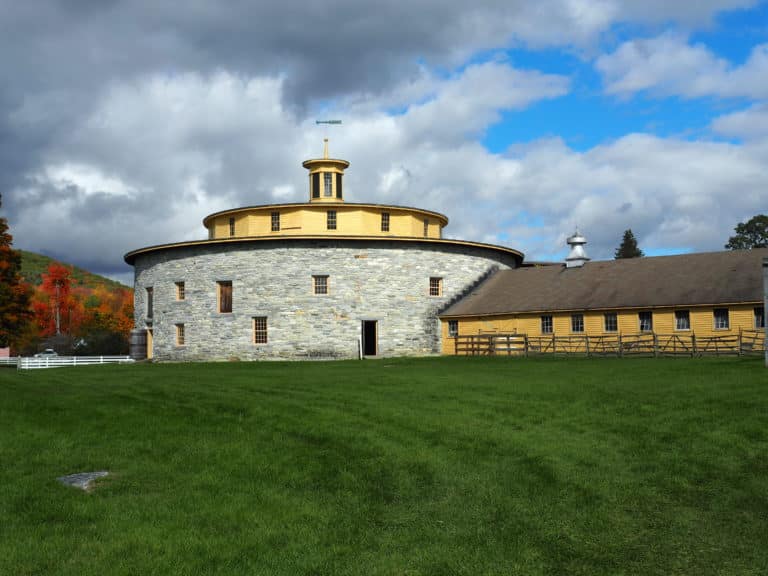
Image by Rick Payette.
The Hidden Presence of a Shaker Library
In her 1999 collection of essays, Geography of Home, Akiko Busch writes about the front door of a house and 12 rooms. The essay titled “Library” begins:
“The Shakers have always irritated me. Not that I don’t love the benches, candle stands, wheelbarrows and chests. But exclude sex and books, as the Shakers did, and you begin to define a starved life… Think of this: a Shaker library. This could be a beautiful thing, a simplicity of shelves and books, a composition of essentials. Such a thing, of course, doesn’t exist.”
If the Shakers did create a library, how would it look? A round table and ladder-back chairs with woven rush seats in the center of a square room. Walls and ceiling are smooth plaster, painted white. Sunlight streams through large windows with no curtains. Cloth-bound books on plain pine shelves stand neatly ranked in their own peculiar categories: agriculture, celestial gifts, English letters, harmony.
The Shakers lived in “families” of up to 100 men and women housed in a single building. Celibate and mystical, they withdrew from the world. It is tempting to see them as home-grown American monks and nuns, their lives dedicated to labor and prayer. Their motto “Hands to work, hearts to God” recalls the ora et labora of Benedictine monks. They taught children born before their parents converted, those of neighbors, and orphans. But adult Shakers did not study, as monks and nuns routinely do.
Drawn from farming people with only a basic education, Shakers aimed to be simple. Their hymn “Simple Gifts,” with its catchy tune used by Aaron Copland in Appalachian Spring, evokes this frame of mind:
‘Tis the gift to be simple, ‘tis the gift to be free,
‘Tis the gift to come down where we ought to be,
And when we find ourselves in the place just right,
‘Twill be in the valley of love and delight.
As Busch observes, the Shakers ignored their Transcendentalist neighbors in Concord, Massachusetts: Emerson, Hawthorne, Thoreau, Melville, and the rest. The utopian experiment of Brook Farm in Roxbury was near Shaker villages in Massachusetts and New Hampshire. But the intellectual life of utopia was alien. One of the Brook Farmers, Nathaniel Hawthorne, writes in his short story “The Shaker Bridal,” published in 1837, of the “Society whose members are generally below the ordinary standard of intelligence.” While that opinion is harsh, Shaker hymns, devotional works, and automatic writing can be naïve and repetitive, with images cribbed from folk art and prophetic biblical books.

The Shakers prohibited books and reading in “retiring rooms,” which were group bedrooms. Newspapers, maps, and pictures were forbidden. Almanacs had to be approved by Elders. Private letters were censored. From the Millennial Laws, adopted in 1821 and revised in 1845:
“The following books may be used, and kept in retiring rooms, viz. bibles, testaments, concordances, such religious books as have been or may be published by believers, dictionaries, grammars, spelling books, and such other books as the leading influence deem profitable for such purposes. But works on the sciences, (except it be moral science) such as natural philosophy, natural, civil, or profane history, biography, miscellany in general, allegory etc. are not suitable to be kept in retiring rooms.”
Their turbulent history led the Shakers to yearn for “order,” a word which they used in several ways. Order could mean “religious orthodoxy,” or their own sect as a “religious order,” or the mundane idea of “everything in its proper place,” or even “law and order.” Social reformers in the early 1800s left or were expelled, and the remaining members turned inward to personal salvation. The millennial laws intended to keep the peace by shutting out the world, though they encouraged practical knowledge. Perhaps they were a compromise.
If so, the compromise carried a hidden cost. Fifty years after it was founded by Mother Ann Lee in 1774, the Shaker movement was calcifying. The shell was implicit in the new revelation. If you have a direct line to God, you don’t need book learning and free discussion. If you are already saved, with no room for improvement, you need only encourage your brothers and sisters, to prevent backsliding.
The literature of mysticism has the drawback that it appeals to saints, not sinners. Thomas Merton, a Cistercian monk in twentieth-century America, the foremost Catholic writer of his generation, wrote on meditation, prayer, and to use the phrase his religious order favored, “the contemplative life.” His books are eloquent and popular. Yet they all say more or less the same thing. They describe the soul at prayer. They do not persuade.
As for the Shakers, what they read and wrote is of no interest to most of us today. What they crafted fascinates us. The text that appeals to us is the context. We like the clean lines, the economy of design, and the purity. The same held true in the nineteenth century. Observers noted the quality of Shaker products and the beauty of their environment. Edward Deming Andrews, in his 1953 book The People Called Shakers, quotes two English visitors, the first writing from New Lebanon.

It was significant, in Dixon’s mind, that the first building he came upon as he entered the village, at its very gateway, so to speak, was a great stone barn. “The granary is to a Shaker,” he felt, “what the Temple was to a Jew.” A traveler “can generally tell when he is come to their possessions,” Warder wrote, “from the excellent improvements. Neatness pervades every department; their fields, orchards, fences, cattle, etc. afford proof of it.”
Perhaps the Shaker Library is a collection of objects, hand-made and manufactured, a clutch of folk art and cultural artifacts. Or perhaps it is their buildings preserved as historic sites: the Shaker Villages at Niskayuna and New Lebanon, New York; Hancock, Massachusetts; and Pleasant Hill, Kentucky. These places and objects are often photographed, and the photographs feature in magazine articles and coffee-table books. By a paradox of publishing, these nonverbal images, printed on glossy paper, are another version of the Shaker Library.
Then again, the text we study is the floor plan of a house, the layout of a garden, and the organization of a Shaker village — a model farm with several thousand acres and more than one “family.” Buildings are carefully designed and color-coded: white for a meeting house, a light hue for dwellings, dark red or brown for barns and back buildings.

We study a chair, an oval box, the sober garb of a Brother or a Sister, as detailed in the Millennial Laws or preserved in examples. We study a “gift drawing” that shows the Tree of Life, a sample of calligraphy, a historic photograph of the people in their setting.
These things are enigmatic, but they tell us sometimes more than words. We can handle the objects. We can visit the villages, walk the fields, and troop inside the buildings. With effort, we can imagine Shaker life.
Above all, it was communal. They abolished private property. They practiced charity to a degree unthinkable today, yet they sharply criticized freeloaders and spongers, men who joined in autumn and left in spring, so-called Winter Shakers. The charity undid profit: the plainness visible everywhere derives as much from poverty as from aesthetic choice.

They practiced political equality of sexes and radical separation of sexes, as we see in the symmetry of their dwellings and meeting houses. Yet symmetry and separation show up in other American buildings of the early nineteenth century. On the whole, a Shaker village looks like a New England mill town. We begin to wonder if Shaker design, which perfected forms already in use, more closely approaches the Platonic idea in metal, fiber, stone, and wood.
The Round Stone Barn at Hancock Shaker Village near Pittsfield, Massachusetts, is a case in point. The barn is solid, huge, and unique. To quote the 1976 guidebook by John Harlow Ott:
“Of all the buildings erected by the United Society, none has attracted more attention than the Round Stone Barn built in 1826. What prompted the building of a round barn will probably never be known, since only scanty documentation exists.”
The guidebook has photographs and a drawing by Eric Sloane, the landscape painter and illustrator of American cultural history. The barn is 90 feet in diameter, with a fieldstone wall and a timber frame.

There are two floors: cattle stalls below in a ring, and a threshing floor above. The open core is for hay storage. The original roof was conical, but after a fire in 1864, it was rebuilt to a lower pitch with a twelve-sided monitor. The barn has windows all around, and a cupola for light and ventilation.

In its later configuration, it sheltered seventy cows from the dairy herd.
The design is said to be practical and efficient. A wagon could drive in the upper floor, make the circuit, and exit through the same door, all without backing up. Trap doors in the lower floor allowed men to shovel manure from the cow stalls to a cellar, and from there to fields for use as fertilizer. But no other Shakers copied the example, nor did anyone else.
The Round Stone Barn is a mystical shape. It recalls the obsession of Italian architects in the sixteenth century with circular temples, to be used as churches despite their awkwardness for Christian ritual. It echoes the circular library, another Renaissance conceit. The Radcliffe Camera at Oxford University, completed by James Gibbs in 1749, is one example. The Reading Room of the British Museum, and the Rotunda of the University of Virginia, designed by Thomas Jefferson as a library, are two more famous circular spaces. They date from 1823 and 1826, contemporary with the barn.
Perhaps this is the Shaker Library, with stalls for cows instead of books. It transcends its context of nineteenth-century agriculture, and of American religious thought, which seldom stoops to farm realities. As architecture, it teases us. Silent and perfect, a lovely form for a lowly function, it asks us what is holy.


